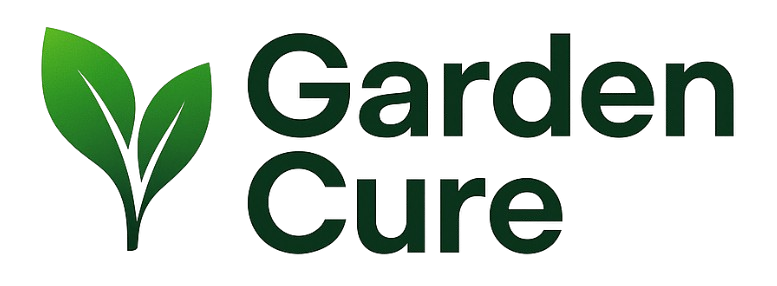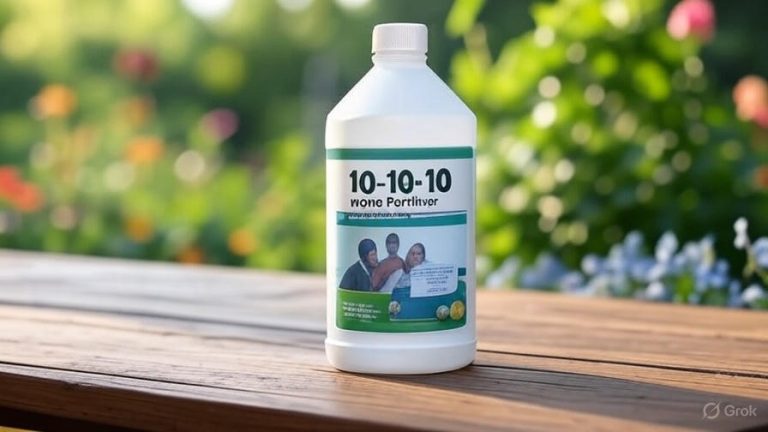5 Best 10-10-10 Fertilizers In 2025
Balanced nutrition forms the foundation of healthy plant growth, and 10-10-10 fertilizers deliver exactly what most gardens need. These all-purpose fertilizers contain equal parts nitrogen, phosphorus, and potassium, creating the perfect nutrient balance for thriving plants. After extensive research and testing, we’ve identified the top 5 balanced fertilizers that will transform your garden into a lush paradise.
Every gardener faces the challenge of providing proper nutrition to their plants. Too much nitrogen creates excessive foliage growth at the expense of flowers and fruits. Insufficient phosphorus leads to poor root development and weak flowering. Potassium deficiency results in reduced disease resistance and poor overall plant health. Balanced 10-10-10 fertilizers solve these problems by delivering equal amounts of all three primary nutrients.
The equal NPK ratio makes these fertilizers incredibly versatile. They work well for establishing new plants, maintaining existing gardens, and supporting both ornamental and edible plants. This balanced approach eliminates the guesswork involved in plant nutrition and provides consistent results across different plant types.
How 10-10-10 Fertilizers Work Their Magic
The three numbers on fertilizer packages represent the percentage of nitrogen (N), phosphorus (P), and potassium (K) by weight. In 10-10-10 fertilizers, each nutrient comprises 10% of the total weight, with the remaining 70% consisting of carrier materials and other beneficial compounds.
Nitrogen drives vegetative growth and produces the deep green color in leaves. This nutrient forms the building blocks of proteins and chlorophyll, making it essential for photosynthesis. Plants deficient in nitrogen display yellowing leaves and stunted growth, while those receiving adequate nitrogen develop strong stems and lush foliage.
Phosphorus supports root development, flower formation, and fruit production. This nutrient plays a crucial role in energy transfer within plants and helps establish strong root systems. New plantings particularly benefit from adequate phosphorus levels, as it encourages rapid root establishment and improves transplant success rates.
Potassium strengthens plant cell walls and improves disease resistance. This nutrient helps plants regulate water uptake and maintains proper cellular function. Plants receiving sufficient potassium demonstrate better drought tolerance and increased resistance to various plant diseases.
The balanced ratio ensures that no single nutrient dominates, preventing the common problems associated with unbalanced fertilization. This approach works particularly well for mixed gardens containing different plant types with varying nutritional needs.
Top 5 Best 10-10-10 Fertilizers Reviewed
1. Southern Ag All Purpose Granular Fertilizer 10-10-10
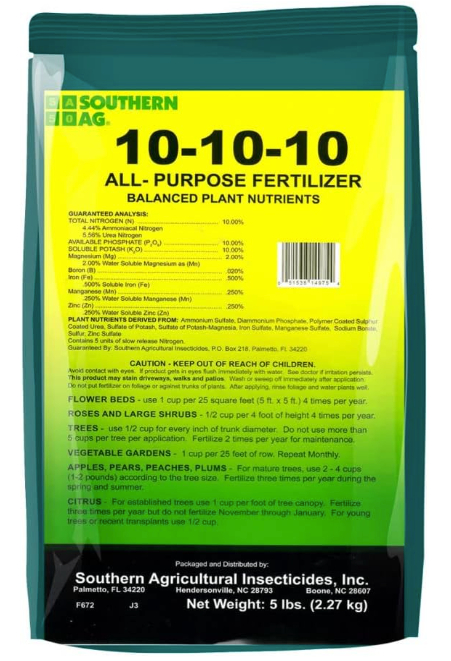
Southern Ag delivers professional-grade nutrition in an easy-to-use granular format. This 5-pound package provides enough fertilizer to feed a substantial garden area while maintaining the quality standards demanded by professional growers.
The granular format releases nutrients gradually, providing steady nutrition over several weeks. This slow-release characteristic prevents nutrient burn and reduces the frequency of applications needed. The uniform granule size ensures even distribution and consistent coverage across your garden beds.
Application proves simple and straightforward. The granules spread easily by hand or with a broadcast spreader, making it suitable for both small garden plots and larger landscape areas. The particles dissolve gradually with each watering or rainfall, delivering nutrients directly to plant roots.
Performance results speak for themselves. Plants treated with Southern Ag fertilizer show improved vigor within two weeks of application. Vegetable gardens produce higher yields, while ornamental plants develop deeper colors and more abundant flowering. The balanced formula works equally well for acid-loving plants and those preferring neutral soil conditions.
The 5-pound size offers excellent value for most home gardens. This quantity covers approximately 1,250 square feet when applied at standard rates, making it perfect for average-sized yards. Storage remains simple due to the resealable package design that protects the fertilizer from moisture and contamination.
Pros:
- Professional-grade formulation
- Even granule distribution
- Long-lasting nutrient release
- Versatile application methods
- Resealable packaging
Cons:
- Limited package size options
- Requires storage protection from moisture
2. GreenView Multi-Purpose Fertilizer 33-Pound Bag
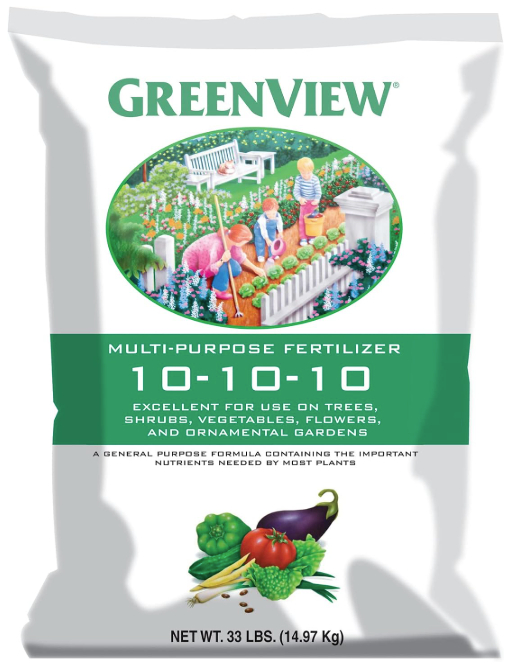
GreenView provides exceptional value with their large 33-pound package that covers extensive garden areas. This bulk option suits gardeners managing large landscapes, multiple garden beds, or those planning season-long nutrition programs.
The generous package size delivers significant cost savings compared to smaller containers. When calculated per pound, this fertilizer offers one of the best values in the balanced fertilizer category. The large quantity ensures you’ll have sufficient fertilizer for multiple applications throughout the growing season.
Granule quality matches that of premium brands while maintaining competitive pricing. The uniform particle size ensures consistent coverage and prevents uneven feeding that can create patchy growth patterns. Each granule contains the same nutrient ratio, guaranteeing balanced nutrition regardless of application method.
Coverage area reaches impressive levels with the 33-pound package. Applied at standard rates, this quantity covers up to 8,250 square feet, making it suitable for large suburban lots or multiple garden areas. The extended coverage makes it practical for gardeners managing extensive vegetable gardens, ornamental beds, and lawn edges simultaneously.
Application flexibility allows for both broadcast spreading and targeted feeding. The granules work well in mechanical spreaders for large areas or can be applied by hand around individual plants. This versatility makes the product suitable for various garden layouts and maintenance approaches.
Pros:
- Exceptional value per pound
- Large coverage area
- Consistent granule quality
- Multiple application methods
- Ideal for extensive gardens
Cons:
- Storage requires adequate space
- Heavy package weight
- May exceed needs for small gardens
3. Slow Release 10-10-10 Plant Fertilizer

The slow-release formula sets this fertilizer apart from quick-release alternatives. Coated granules release nutrients gradually over 8-10 weeks, providing consistent nutrition without the peaks and valleys associated with standard fertilizers. This extended feeding reduces application frequency and prevents nutrient waste.
Plant response demonstrates the effectiveness of slow-release technology. Instead of rapid initial growth followed by nutrient depletion, plants receiving this fertilizer maintain steady growth rates throughout the feeding period. This consistent nutrition produces stronger plants with better disease resistance and improved stress tolerance.
The 1/2 quart package size makes this fertilizer ideal for container gardens, small beds, and targeted plant feeding. While the quantity appears modest, the concentrated nature and extended release period provide excellent value. This size works perfectly for urban gardeners, apartment dwellers, and those maintaining small specialty gardens.
Versatility extends across numerous plant types. The balanced formula supports vegetable production, ornamental flowering, shrub establishment, and tree feeding. The product description specifically mentions effectiveness with tomatoes, arborvitae, shrubs, roses, flowers, fruit trees, and fig trees, demonstrating its broad applicability.
Application simplicity makes this fertilizer accessible to gardeners of all experience levels. The granules scatter easily around plants and require only light watering to activate. No complex mixing or measuring procedures are needed, reducing the chance of application errors.
Pros:
- Extended 8-10 week feeding period
- Consistent nutrient release
- Suitable for diverse plant types
- Simple application process
- Ideal for small gardens
Cons:
- Higher cost per pound
- Limited package size
- Not suitable for large-scale applications
4. Triple 10 All Purpose Liquid Fertilizer with Amino Acids
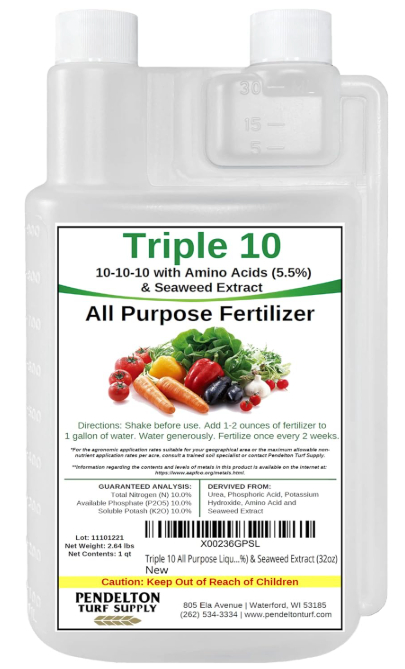
Liquid fertilizers offer distinct advantages over granular alternatives, and Triple 10 maximizes these benefits. The liquid format provides immediate nutrient availability, making it ideal for quick plant response situations or addressing acute nutrient deficiencies.
The amino acid addition sets this product apart from standard liquid fertilizers. These organic compounds enhance nutrient uptake and improve plant stress tolerance. Amino acids act as chelating agents, helping plants absorb nutrients more efficiently and maintain health during challenging growing conditions.
Seaweed extract contributes additional micronutrients and growth hormones not found in synthetic fertilizers. This natural additive improves root development, enhances flowering, and increases overall plant vigor. The seaweed component also provides natural plant growth regulators that promote balanced development.
Application versatility makes this liquid fertilizer suitable for multiple feeding methods. It works as a soil drench for root feeding, foliar spray for quick nutrient absorption, or hydroponic solution for soilless growing systems. This flexibility accommodates various gardening styles and plant growing situations.
The 32-ounce bottle provides concentrated nutrition that dilutes to create many gallons of fertilizer solution. When mixed according to label directions, this quantity provides enough fertilizer for extensive garden feeding or season-long container plant nutrition. The concentrated format reduces storage space requirements and shipping costs.
Pros:
- Immediate nutrient availability
- Enhanced with amino acids and seaweed
- Multiple application methods
- Concentrated formula
- Suitable for hydroponic systems
Cons:
- Requires more frequent applications
- Higher per-application cost
- Needs proper dilution
- Storage considerations for liquids
5. Espoma 10-10-10 Garden Food

Espoma brings organic-based nutrition to the balanced fertilizer category. Their 6.75-pound package combines traditional NPK nutrition with organic matter and beneficial microorganisms that improve soil health over time.
The organic component distinguishes Espoma from purely synthetic alternatives. Organic matter improves soil structure, enhances water retention, and provides food for beneficial soil microorganisms. This approach creates sustainable nutrition that builds soil health while feeding plants.
Granular format ensures easy application and gradual nutrient release. The particles break down naturally in soil, releasing nutrients as plants need them. This natural release pattern prevents nutrient burn and provides extended feeding periods between applications.
Plant compatibility extends across all garden types mentioned in the product description. Flowering plants, trees, shrubs, and vegetables all respond positively to Espoma’s balanced nutrition. The organic base makes it particularly suitable for edible gardens where soil health and food safety are primary concerns.
Package size suits most home gardens while providing good value. The 6.75-pound quantity covers approximately 1,688 square feet at standard application rates, making it appropriate for average suburban lots. The size balances coverage area with storage convenience and cost considerations.
Quality control maintains Espoma’s reputation for consistent products. Each package contains uniform granules with reliable nutrient content. The company’s long history in organic gardening products provides confidence in product performance and safety.
Pros:
- Organic-based formulation
- Improves soil health
- Safe for edible gardens
- Established brand reputation
- Appropriate package size
Cons:
- Higher cost than synthetic alternatives
- Slower initial response
- Limited availability in some areas
Application Techniques for Maximum Results
Proper application determines fertilizer effectiveness regardless of which product you select. Timing, placement, and technique all influence how well plants utilize available nutrients.
Soil preparation creates the foundation for successful fertilization. Test soil pH before applying any fertilizer, as nutrient availability depends heavily on proper pH levels. Most plants prefer slightly acidic to neutral soil (pH 6.0-7.0), where nutrients remain readily available for plant uptake.
Application timing affects nutrient utilization and plant response. Apply fertilizers during active growing periods when plants can immediately use available nutrients. Early spring applications support initial growth, while mid-season feeding maintains vigor during peak growing periods.
Granular fertilizer application requires even distribution to prevent uneven plant growth. Use a broadcast spreader for large areas or scatter by hand for smaller spaces. Apply fertilizer to dry soil and water thoroughly after application to activate nutrient release.
Liquid fertilizer application offers more precise control over nutrient delivery. Dilute concentrates according to label directions and apply during calm weather conditions. Early morning or late evening applications prevent leaf burn and allow maximum nutrient absorption.
Incorporation techniques improve fertilizer effectiveness for new plantings. Work granular fertilizers into the top 4-6 inches of soil before planting to place nutrients in the root zone. This approach ensures immediate nutrient availability as roots develop.
Seasonal Application Strategies
Spring applications jumpstart the growing season by providing nutrients as plants emerge from dormancy. Apply balanced fertilizers 2-3 weeks before the last expected frost to prepare soil for planting season. This timing allows nutrients to become available as soil temperatures warm and root activity increases.
Early season feeding supports rapid establishment of new plantings and vigorous growth of returning perennials. Plants utilize high nitrogen levels during this period to develop strong vegetative growth that supports later flowering and fruiting.
Summer maintenance feeding sustains plant growth during peak growing periods. Apply fertilizers every 6-8 weeks during active growing seasons to maintain consistent nutrition levels. Monitor plants for signs of nutrient deficiency and adjust application frequency accordingly.
Mid-season applications prove particularly important for heavy-feeding plants like tomatoes, corn, and flowering annuals. These plants deplete soil nutrients rapidly and benefit from regular fertilizer applications throughout the growing season.
Fall fertilization preparations plants for winter dormancy while building nutrient reserves for the following season. Apply balanced fertilizers 6-8 weeks before the first expected frost to allow plants time to utilize nutrients before growth slows.
Late-season feeding supports root development and carbohydrate storage that improves winter survival and early spring growth. Avoid high-nitrogen fertilizers late in the season, as they can stimulate tender growth susceptible to frost damage.
Organic vs. Synthetic: Making the Right Choice
Synthetic fertilizers provide immediate nutrient availability and precise nutrient ratios. These products dissolve quickly in soil water, making nutrients immediately available for plant uptake. The predictable nutrient content allows for precise feeding programs and consistent results.
Cost effectiveness favors synthetic fertilizers for large-scale applications. The concentrated nutrient content and lower production costs result in less expensive per-unit nutrition compared to organic alternatives. This advantage becomes significant when managing extensive garden areas.
Organic fertilizers improve soil health through the addition of organic matter and beneficial microorganisms. These products release nutrients gradually as organic components decompose, providing extended feeding periods and reducing the risk of nutrient burn.
Environmental considerations often favor organic products due to their lower impact on groundwater and soil ecosystems. Organic fertilizers build soil structure and support beneficial soil life, creating sustainable growing conditions over time.
Performance differences exist between organic and synthetic options. Synthetic fertilizers typically produce faster initial response and more predictable results. Organic fertilizers provide longer-lasting benefits and improve overall soil health, though initial response may be slower.
Application frequency varies between product types. Synthetic fertilizers usually require more frequent applications to maintain consistent nutrition levels. Organic fertilizers often provide extended feeding periods, reducing application frequency and labor requirements.
Common Application Mistakes to Avoid
Over-fertilization ranks as the most common mistake made by enthusiastic gardeners. Excessive fertilizer application can burn plant roots, promote excessive vegetative growth at the expense of flowering, and contribute to environmental pollution through nutrient runoff.
Signs of over-fertilization include rapid, soft growth that attracts pests and diseases. Plants may produce abundant foliage but few flowers or fruits. Salt buildup in soil can also occur, creating drought-like symptoms even in well-watered plants.
Under-fertilization produces equally disappointing results. Nutrient-deficient plants display yellowing leaves, stunted growth, and poor flowering. These plants also show increased susceptibility to pests and diseases due to weakened plant vigor.
Timing errors reduce fertilizer effectiveness and may harm plants. Applying fertilizers too early exposes plants to nutrient burn when root activity is low. Late-season applications can stimulate growth that doesn’t have time to harden off before frost.
Uneven application creates patchy growth patterns that detract from garden appearance. Some plants receive excessive nutrition while others remain deficient. This problem particularly affects granular fertilizer applications made without proper spreading equipment.
Watering mistakes compound fertilizer application errors. Insufficient watering after application prevents nutrient activation and may concentrate fertilizer salts around plant roots. Excessive watering immediately after application can wash nutrients away before plants can utilize them.
Maximizing Plant Response
Soil testing provides the foundation for effective fertilization programs. Test results reveal existing nutrient levels and soil pH, allowing you to adjust fertilizer applications accordingly. Annual soil tests help track changes in soil fertility and guide fertilizer selection.
Plant-specific nutrition requirements vary considerably between species. While 10-10-10 fertilizers work well for most plants, some species benefit from modified ratios. Research specific requirements for your most important plants and adjust fertilization accordingly.
Growth stage considerations influence fertilizer effectiveness. Young plants establishing root systems benefit from phosphorus-rich fertilizers. Mature plants in active growth require balanced nutrition. Plants preparing for dormancy need reduced nitrogen and increased potassium.
Environmental factors affect nutrient availability and plant response. Temperature, moisture, and light levels all influence how effectively plants utilize available nutrients. Adjust fertilizer applications based on growing conditions and plant performance.
Companion planting strategies can enhance fertilizer effectiveness. Some plants improve soil conditions for neighboring species, while others may compete for nutrients. Plan garden layouts to maximize fertilizer benefits across all planted areas.
Mulching practices influence fertilizer performance by regulating soil temperature and moisture levels. Organic mulches decompose to provide additional nutrients, while synthetic mulches focus on moisture conservation and weed control.
Storage and Safety Considerations
Proper storage extends fertilizer shelf life and maintains product effectiveness. Store granular fertilizers in cool, dry locations protected from moisture and temperature extremes. Sealed containers prevent moisture absorption and contamination from pests or debris.
Safety precautions protect both gardeners and the environment during fertilizer handling and application. Wear appropriate protective equipment including gloves and eye protection when handling concentrated fertilizers. Avoid breathing dust from granular products during application.
Application safety requires attention to weather conditions and timing. Avoid applying fertilizers immediately before heavy rain that may wash nutrients into waterways. Wind conditions can affect application accuracy and may blow granules into unintended areas.
Child and pet safety considerations are essential when using and storing fertilizers. Keep all fertilizer products in original containers with labels intact. Store products in locations inaccessible to children and pets. Clean up spilled fertilizer immediately to prevent accidental ingestion.
Environmental protection involves responsible application rates and timing. Follow label directions precisely to prevent over-application and nutrient runoff. Avoid applying fertilizers to frozen ground or areas with poor drainage where runoff is likely.
Equipment maintenance ensures safe and effective fertilizer application. Clean spreaders and sprayers thoroughly after each use to prevent fertilizer buildup and corrosion. Calibrate equipment regularly to ensure accurate application rates.
Cost Analysis and Value Comparison
Price per pound varies significantly between different 10-10-10 fertilizer options. Bulk packages typically offer better value than smaller containers, though they require adequate storage space and may exceed the needs of small gardens.
Coverage calculations help determine the most economical choice for your specific needs. Calculate the cost per square foot of coverage to compare products accurately. Consider both initial cost and application frequency when evaluating total seasonal costs.
Quality factors justify price differences between products. Premium fertilizers may include beneficial additives like organic matter, micronutrients, or slow-release coatings that provide added value beyond basic NPK nutrition.
Long-term value considerations extend beyond initial purchase price. Products that improve soil health or provide extended feeding periods may offer better overall value despite higher upfront costs.
Application labor represents a hidden cost often overlooked in fertilizer comparisons. Products requiring frequent applications increase labor costs and time investment. Slow-release formulations may justify higher prices through reduced application frequency.
Storage costs affect the total cost of ownership for bulk fertilizer purchases. Factor in storage container costs and space requirements when evaluating large package options.
Environmental Impact and Sustainability
Nutrient runoff poses the primary environmental concern associated with fertilizer use. Excess nutrients entering waterways contribute to algae blooms and aquatic ecosystem disruption. Proper application rates and timing minimize runoff potential.
Soil health impacts vary between organic and synthetic fertilizer types. Organic fertilizers generally improve soil structure and support beneficial microorganisms. Synthetic fertilizers provide concentrated nutrition but may not contribute to long-term soil health.
Carbon footprint considerations include both product manufacturing and transportation impacts. Locally produced organic fertilizers typically have lower carbon footprints than synthetic products manufactured from fossil fuels and transported long distances.
Packaging waste varies significantly between product types and sizes. Bulk packages reduce packaging waste per unit of fertilizer but may use more robust containers. Consider packaging recyclability when evaluating environmental impact.
Water quality protection requires responsible fertilizer use practices. Apply fertilizers according to soil test recommendations rather than maximum label rates. Time applications to coincide with plant uptake capacity rather than convenience.
Biodiversity support through sustainable fertilization practices benefits entire garden ecosystems. Healthy soil supports beneficial insects, soil organisms, and plant diversity that creates resilient garden environments.
Making Your Final Decision
Garden size represents the primary factor in fertilizer selection. Small gardens benefit from concentrated products or smaller packages, while extensive landscapes require bulk options for economic efficiency.
Plant diversity in your garden influences fertilizer choice. Mixed gardens with varying plant types benefit from balanced 10-10-10 formulations. Specialized gardens may require modified nutrient ratios for optimal results.
Application preferences affect product selection. Gardeners preferring low-maintenance approaches benefit from slow-release formulations. Those wanting maximum control over plant nutrition may prefer liquid fertilizers with flexible application timing.
Budget considerations include both initial costs and long-term value. Evaluate total seasonal costs including application frequency and coverage area when comparing options.
Experience level influences successful fertilizer use. Beginning gardeners benefit from simple, balanced formulations with clear application instructions. Experienced gardeners may prefer products offering more control over nutrition programs.
Environmental priorities guide product selection for many gardeners. Those prioritizing soil health and sustainability often prefer organic options despite higher costs. Others focus on immediate results and cost-effectiveness offered by synthetic alternatives.
Conclusion
The five 10-10-10 fertilizers reviewed offer distinct advantages for different gardening situations. Southern Ag provides professional-grade nutrition in a convenient package size. GreenView delivers exceptional value for large-scale applications. The slow-release option offers extended feeding with reduced application frequency. Triple 10 liquid fertilizer provides immediate results with beneficial additives. Espoma combines balanced nutrition with organic soil improvement.
Success with any fertilizer depends on proper application timing, appropriate rates, and attention to plant response. Regular soil testing guides fertilizer selection and application rates for optimal results. Environmental responsibility ensures that fertilizer use supports both plant health and ecosystem protection.
The balanced 10-10-10 ratio works well for most garden situations, providing equal amounts of the three primary nutrients plants need. This balanced approach eliminates guesswork and supports healthy plant development across diverse plant types.
Your specific garden needs, budget, and environmental priorities will guide the best choice among these excellent options. Each product offers proven performance when applied correctly and consistently throughout the growing season.
